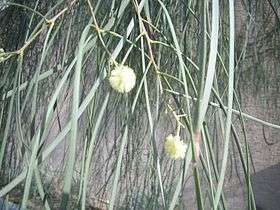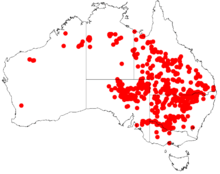Acacia stenophylla
Acacia stenophylla, the shoestring acacia, is an evergreen tree in the family Fabaceae native to Australia
| Acacia stenophylla | |
|---|---|
 | |
| Scientific classification | |
| Kingdom: | Plantae |
| Clade: | Tracheophytes |
| Clade: | Angiosperms |
| Clade: | Eudicots |
| Clade: | Rosids |
| Order: | Fabales |
| Family: | Fabaceae |
| Clade: | Mimosoideae |
| Genus: | Acacia |
| Species: | A. stenophylla |
| Binomial name | |
| Acacia stenophylla A.Cunn. ex Benth. | |
 | |
| Occurrence data from AVH | |
| Synonyms | |
Description
Acacia stenophylla is a fast-growing tree, that grows to 4–10 metres (13–33 ft) tall.[2] The form is upright with decumbent or weeping branches and foliage. The leaves are gray to gray-green, narrow and long.
Acacia stenophylla has medium salt and frost tolerance. The average minimum annual rainfall that the tree needs is around 400 mm (16 in) per year.[2] It is not listed as a threatened species.[1]
Common names
Common names used in Australia include Balkura, Belalie, Black Wattle, Dalby Myall, Dalby Wattle, Dunthy, Eumong, Gooralee, Gurley, Ironwood, Munumula, Native Willow, River Cooba, River Cooba, and River Myall.[1]
Etymology
The specific epithet is derived from the Greek stenos (narrow) and phyllon (leaf) to give “with narrow leaves”.[3]
Uses
The plant is said to contain medicinal alkaloids.[4]
Acacia stenophylla is widely planted as a drought tolerant and decumbent ornamental tree. It is cultivated by plant nurseries, and used in modernist gardens and in public landscapes in the Southwestern United States and California.
Gallery
 Acacia stenophylla – form
Acacia stenophylla – form Acacia stenophylla – bark
Acacia stenophylla – bark Acacia stenophylla – with seed pods
Acacia stenophylla – with seed pods
References
- ILDIS LegumeWeb
- Dry Area Species
- "Plantillustrations.org Epithet: stenophyllus,-a,-um". Retrieved 3 December 2018.
- "Lycaeum". Archived from the original on 2007-09-30. Retrieved 2007-06-18.
| Wikimedia Commons has media related to Acacia stenophylla. |
External links
- CSIRO Csiro.au: Acacia stenophylla - Australian publication